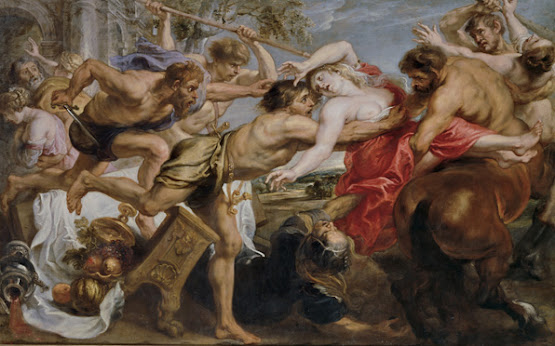Blazon (pronounced bley-zuhn)
(1) In heraldry,
an escutcheon or coat of arms or a banner depicting a coat of arms.
(2) In heraldry,
a description (verbal or written or in an image) of a coat of arms.
(3) In heraldry,
a formalized language for describing a coat of arms (the heraldic description
of armorial bearings).
(4) An ostentatious
display, verbal or otherwise.
(5) A description
or recording (especially of the good qualities of a person or thing).
(6) In
literature, verses which dwelt upon and described various parts of a woman's body (usually in admiration).
(7) Conspicuously
or publicly to set forth; display; proclaim.
(8) To
adorn or embellish, especially brilliantly or showily.
(9) To
depict (heraldic arms or the like) in proper form and color.
(10) To
describe a coat of arms.
1275-1300: From the late thirteenth century Middle English blazon (armorial bearings, coat of arms), from the twelfth century Old French blason (shield, blazon (also “collar bone”). Of the words in the Romance languages (the Spanish blason, Italian blasone, Portuguese brasao & Provençal blezo, the first two are said to be French loan-words and the origins of all remain uncertain. According to the OED (Oxford English Dictionary), the suggestion by nineteenth century French etymologists of connections with Germanic words related to English blaze is dubious because of the sense disparities. The verb blazon (to depict or paint (armorial bearings) dates from the mid sixteenth century and was either (or both) from the noun or the French blasonner (from the French noun). In English, it had earlier in the 1500s been used to mean “descriptively to set forth; descriptively” especially (by at least the 1530s) specifically “to vaunt or boast” and in that sense it was probably at least influenced by the English blaze. Blazon & blazoning are nouns & verbs, blazoner, blazonry & blazonment are nouns and blazoned & blazonable are adjectives; the noun plural is blazons.
The now more familiar verb emblazon (inscribe conspicuously) seems first to have been used around the 1590s in the sense of “extol” and the still common related forms (emblazoning; emblazoned) emerged almost simultaneously. The construct of emblazon was en- + blazon (from the Old French blason (in its primary sense of “shield”). The en- prefix was from the Middle English en- (en-, in-), from the Old French en- (also an-), from the Latin in- (in, into). It was also an alteration of in-, from the Middle English in-, from the Old English in- (in, into), from the Proto-Germanic in (in). Both the Latin & Germanic forms were from the primitive Indo-European en (in, into). The intensive use of the Old French en- & an- was due to confluence with Frankish intensive prefix an- which was related to the Old English intensive prefix -on. It formed a transitive verb whose meaning is to make the attached adjective (1) in, into, (2) on, onto or (3) covered. It was used also to denote “caused” or as an intensifier. The prefix em- was (and still is) used before certain consonants, notably the labials “b” & “p”.
Google ngram: It shouldn’t be surprising there seems to have been a decline in the use of “blazon” while “emblazoned” has by comparison, in recent decades, flourished. That would reflect matters of heraldry declining in significance, their appearance in printed materials correspondingly reduced in volume. However, because of the way Google harvests data for their ngrams, they’re not literally a tracking of the use of a word in society but can be usefully indicative of certain trends, (although one is never quite sure which trend(s)), especially over decades. As a record of actual aggregate use, ngrams are not wholly reliable because: (1) the sub-set of texts Google uses is slanted towards the scientific & academic and (2) the technical limitations imposed by the use of OCR (optical character recognition) when handling older texts of sometime dubious legibility (a process AI should improve). Where numbers bounce around, this may reflect either: (1) peaks and troughs in use for some reason or (2) some quirk in the data harvested.
Impressionistically
though this assumption is, few would doubt “blazon” is now rare while “emblazoned”
is far from uncommon. While “emblazon”
began with the meaning “that which the emblazoner does” (ie (1) to adorn with
prominent, (2) to inscribe upon and (3) to draw a coat of arms) it evolved by
the mid-nineteenth century with the familiar modern sense of “having left in
the mind a vivid impression” (often in the form “emblazoned on one’s memory”). In English, there’s nothing unusual in a derived
or modified form of a word becoming common than its original root, even to the
point the where the original is rendered rare, unfamiliar or even obsolete, a phenomenon
due to changes in usage patterns, altered conventions in pronunciation or
shifts in meaning that make the derived form more practical or culturally
resonant. That’s just how English
evolves.
Other
examples include (1) ruthless vs. ruth (ruth (pity; compassion) was once a common
noun in Middle English but has long been extinct while ruthless, there being many who demand the description, remains
popular), (2) unkempt vs kempt (kempt (neatly kept) would have been listed as
extinct were it not for it finding a niche as a literary and poetic form and
has also been used humorously or ironically), (3) disheveled vs sheveled (sheveled
was from the Old French chevelé (having
hair) and was part of mainstream vocabulary as late as the eighteenth century
but, except in jocular use, is effectively non-existent in modern English) and
(4) redolent vs dolent (redolent (evocative of; fragrant) was from dolent (sorrowful),
from the Latin dolere (to feel pain));
redolent both outlived and enjoyed a meaning-shift from its root.
Etymologists
think of these as part of the linguistic fossil record, noting there’s no
single reason for the phenomenon beyond what survives being better adapted to cultural
or conversational needs. In that, these
examples differ from the playful fork of back-formation which has produced (1) combobulate (a back-formation from discombobulate
(to confuse or disconcert; to throw into a state of confusion) which was a
humorous mock-Latin creation in mid-nineteenth century US English) (2) couth (a
nineteenth century back-formation from uncouth and used as a humorous form
meaning “refined”), (3) gruntled (a twentieth
century back-formation meaning “happy or contented; satisfied”, the source being
disgruntled (unhappy; malcontented) and most sources indicate it first appeared
in print in 1926 but the most celebrated example comes from PG Wodehouse
(1881–1975) who in The Code of the
Woosters (1938) penned: “He spoke with a certain what-is-it in his voice, and I
could see that, if not actually disgruntled, he was far from being gruntled.” Long a linguistic joke, some now take
gruntled seriously but for the OED remains thus far unmoved and (4) ept (a back-formation from inept (not
proficient; incompetent or not competent (there is a functional difference
between those two)) which was from the Middle French inepte, from the Latin ineptus).
Literary
use
In literary
use, “blazon” was a technical term used by the Petrarchists (devotes of Francis
Petrarch (1304-1374), a scholar & poet of the early Italian
Renaissance renowned for his love poems & sonnets and regarded also as one of the earliest humanists). Blazon in this context (a subset of what
literary theorists call “catalogue verse”) was adopted because, like the structured
and defined elements of heraldic symbolism, Petrarch’s poems contained what
might be thought an “inventory” of verses which dwelt upon and detailed the
various parts of a woman's body; a sort of catalogue of her physical attributes. Petrarch’s approach wasn’t new because as a
convention in lyric poetry it was well-known by the mid thirteenth century,
most critics crediting the tradition to the writings of Geoffrey of Vinsauf, a figure about
whom little is although it’s believed he was born in Normandy. In England the Elizabethan sonneteers
honed the technique as a devotional device, often, in imaginative ways,
describing the bits of their mistresses
they found most pleasing, a classic example a fragment from Amoretti and Epithalamion (1595), a wedding day ode by the English poet Edmund Spenser (circa 1552-1599) to his bride (Elizabeth
Boyle) in 1594:
Her goodly eyes like
sapphires shining bright.
Her forehead ivory
white,
Her cheeks like apples
which the sun hath rudded,
Her lips like cherries
charming men to bite,
Her breast like to a
bowl of cream uncrudded,
Her paps like lilies
budded,
Her snowy neck like to
a marble tower,
And all her body like a
palace fair.
So
objectification of the female form is nothing new and the poets saw little
wrong with plagiarism, most of the imagery summoned salvaged from the works of Antiquity
by elegiac Roman and Alexandrian Greek poets.
Most relied for their effect on brevity, almost always a single, punchy
line and none seem ever to attempt the scale of the “epic simile”. As can be imagined, the novelty of the
revival didn’t last and the lines soon were treated by readers (some of whom
were fellow poets) as clichés to be parodied (a class which came to be called “contrablazon”),
the London-based courtier Sir Philip Sidney (1554–1586) borrowing from the
Italian poet Francesco Berni (1497–1535) the trick of using terms in the style
of Petrarch but “mixing them up”, thus creating an early form of body dysmorphia:
Mopsa's forehead being “jacinth-like”, cheeks of “opal”, twinkling eyes “bedeckt with
pearl” and lips of “sapphire blue”.
William
Shakespeare (1564–1616) however saw other possibilities in the blazon and in Sonnet 130 (1609) turned the idea on its
head, listing the imperfections in her body parts and characteristics yet
concluding, despite all that, he anyway adored her like no other (here rendered in a more accessible English):












%20Death%20of%20a%20Centaur%20(1912).jpg)










